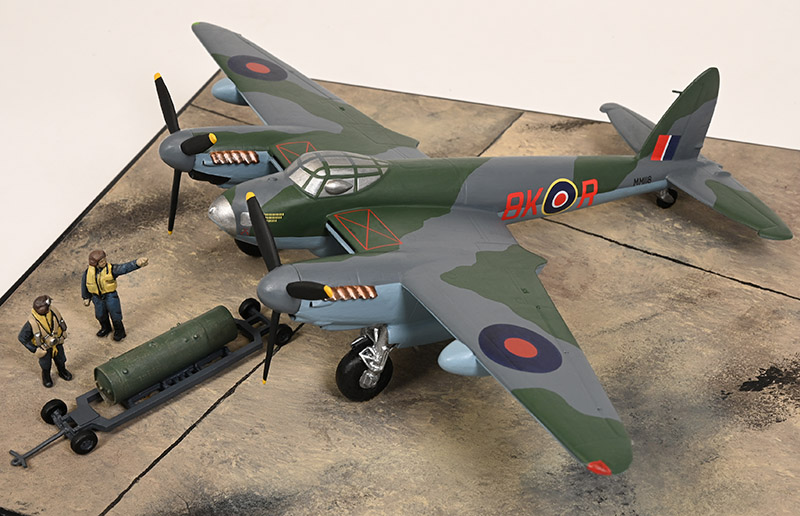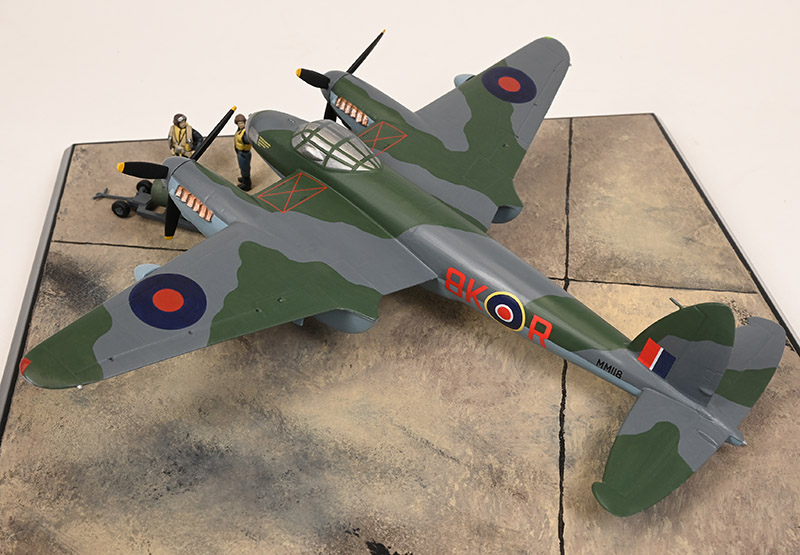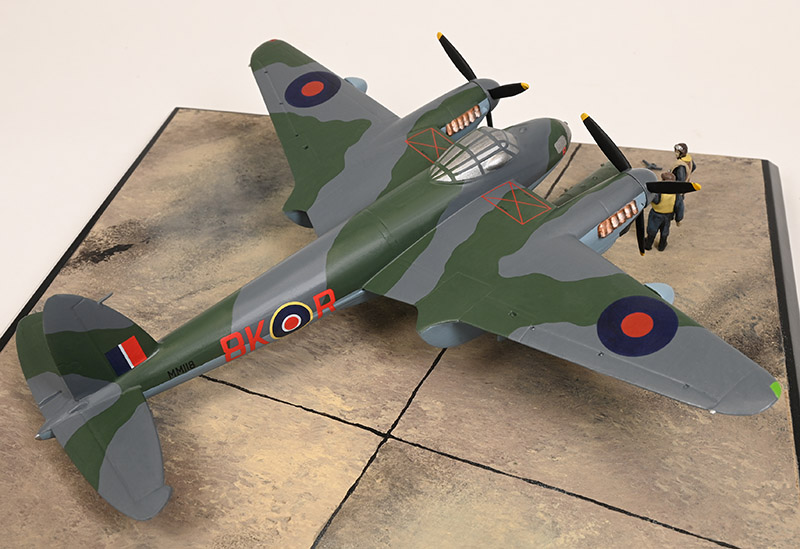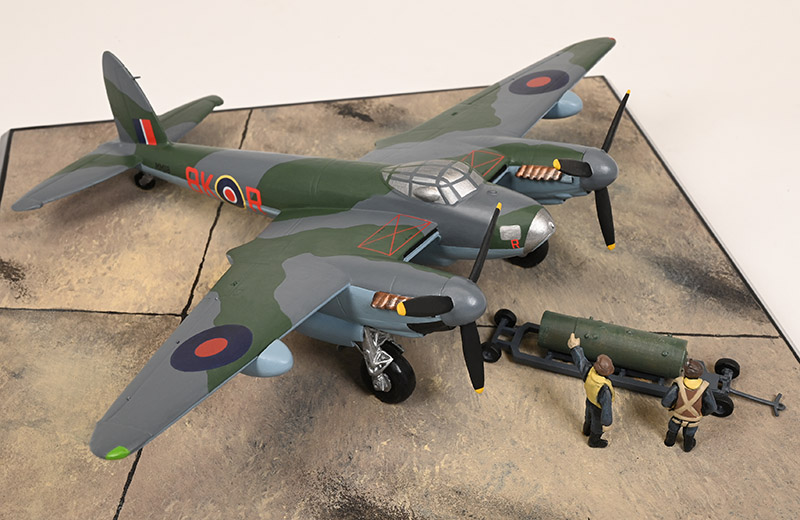de Havilland Mosquito B Mk XVI
De Havilland Mosquito B Mk XVI MM118
8K-R 571 Squadron, RAF Oakington, August 1944
Flt / Lt I. G. Broom DFC*, Flt / Lt T.J. Broom DFC
As with any successful aircraft of the Second World War the Mosquito was quickly developed for various roles. Serving as a nightfighter, fighter bomber and in the photo reconnaissance role the Mosquito excelled. But it was originally designed as a bomber and in this role it excelled. It’s strong lightweight construction coupled with twin Rolls-Royce Merlin engines gave it speed and agility that many air-forces coveted.
While timber construction was considered outmoded by some, de Havilland claimed that their successes with techniques used for the DH 91 Albatross could lead to a fast, light bomber using monocoque-sandwich shell construction. Arguments in favour of this included speed of prototyping, rapid development, minimisation of jig-building time, and employment of a separate category of workforce. The ply-balsa-ply monocoque fuselage and one-piece wings with doped fabric covering would give excellent aerodynamic performance and low weight, combined with strength and stiffness. At the same time, the design team had to fight conservative Air Ministry views on defensive armament. Guns and gun turrets, favoured by the ministry, would impair the aircraft’s aerodynamic properties and reduce speed and manoeuvrability, in the opinion of the designers. Whilst submitting these arguments, Geoffrey de Havilland funded his private venture until a very late stage. The project was a success beyond all expectations
Developed from the Mosquito Mk IV the Mk XVI was powered by the two stage supercharged Merlin and featured a pressurised cockpit. But most significantly it featured an enlarged bomb-bay capable of carrying the 4,000lb (1,800 Kg) ‘Cookie’ bomb. This new Mk XVI could carry the same bomb load as a B-17 ‘Flying Fortress’. The difference being that the Mosquito could deliver it’s payload to Berlin twice in one day. But it wasn’t only the fact that the Mk XVI had a vast bomb load that made it so special. It’s agility meant that it could be used for precision bombing of very specific targets. This was something that was previously impossible.
This was something that was not lost on the RAF. An elite force was formed known as the ‘Pathfinder Force’. Their role was to go ahead of the main bomber force and mark the targets helping the bombers delivery their payloads to exactly the right destination.
Talented pilots and navigators were selected from squadrons across the RAF and formed these new elite squadrons. Two such aircrew were Flt / Lt I. G. Broom DFC* and Flt / Lt T.J. Broom DFC.
Flt / Lt Ivor Broom DFC* was born in Cardiff, Wales and educated at the Boy’s County School, Pontypridd. At 17, Broom passed the Civil Service Exam and began work with the Inland Revenue. Broom learned to fly in 1940 while the Battle of Britain was being fought, and was posted to No. 114 Squadron in 1941. The squadron were flying Bristol Blenheim light bombers which were flown in low-level daylight operations against Channel and North Sea shipping as well as targets along the French, Dutch and German coasts. He took part in the successful raid against the Goldenburg-Werk lignite power stations, Knapsack, Germany in August 1941. In late 1941, while still a sergeant, Broom was detailed to lead a flight of six Blenheims to reinforce Singapore, en route the bombers landed on Malta which was under siege at the time by the Axis. When they landed on the island, Air Vice Marshal Hugh Pughe Lloyd commandeered Broom and his aircraft to replace the islands losses, the other five Blenheims flying on to Singapore.
Flt /Lt Tommy Broom DFC was born in Portishead, Somerset, on 22 January 1914 and educated at Slade Road School. After leaving school Broom got a job in a local garage. He soon grew bored and, in 1932, joined the Royal Air Force (RAF) where he trained to be a navigator. He was mobilised to France at the outbreak of the Second World War, assigned to No. 105 Squadron operating Fairey Battle light bombers. After the German Blitzkrieg through France in 1940, Broom returned home and transferred to No. 13 Operational Training Unit at Bicester, where he taught navigators the skills required for combat. He returned to No. 105 Squadron in 1942 and completed another tour, after which he was posted to 1655 Mosquito Training Unit where he remained until May 1944. Subsequent to this he returned to front-line flying until the end of the war, with Nos. 571, 128 and 163 (Mosquito) Squadrons.
It was no coincidence these two were to form a crew no doubt to the amusement of the squadron they were known as ‘The Flying Brooms’ and flew many operations together becoming life-long friends.
Flt /Lt Ivor Broom remained in the RAF after the war and rose through the ranks to become an Air Vice Marshal and be Knighted receiving many decorations in his career.
Scale 1:72 Wingspan 9.03″ (229 mm)
Base size 9.33″ (237 mm) square (No. 6)
Weight not including base 1lb 5.3 ozs (604 grams)
Limited edition of 25 only
SOLD OUT





